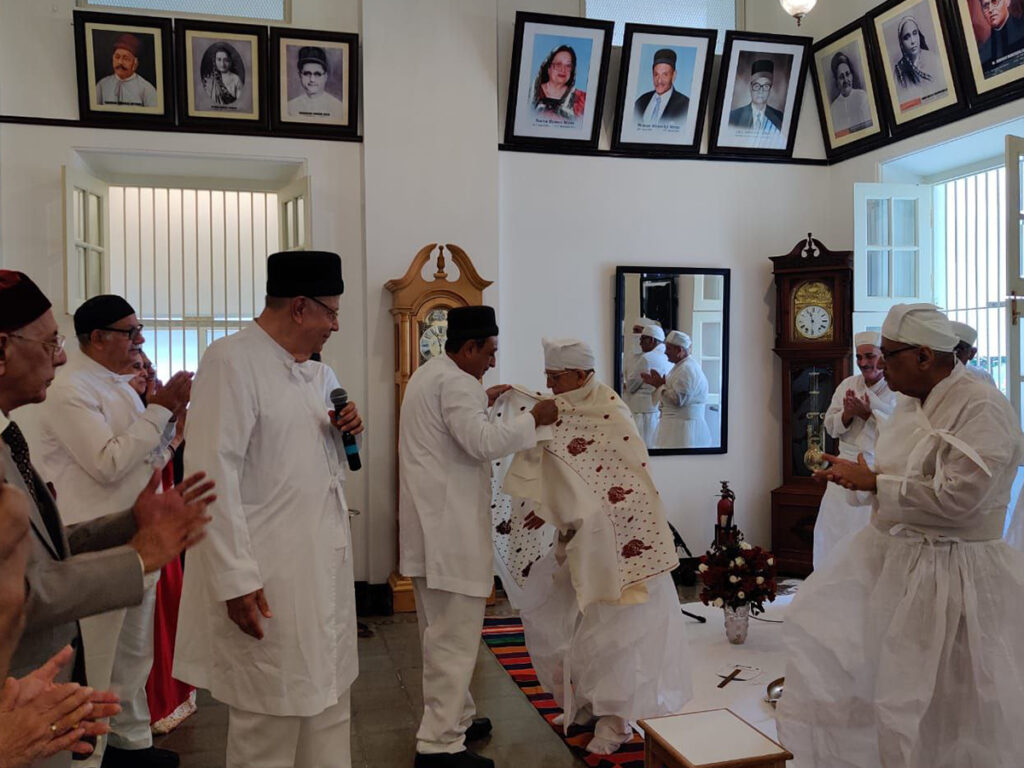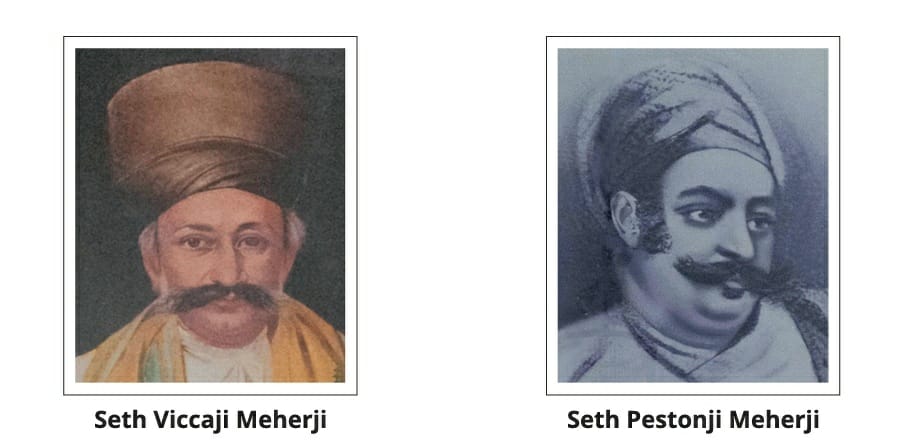Hyderabad: Members of the Parsi community from the city celebrated the 175th anniversary of the Seth Viccaji – Seth Pestonji Meherji Parsi fire temple on Sunday. The 1000-odd Parsis (Zoroastrians) from Hyderabad’s 400+ families participated in the ‘Khushboo Nu Jashn’ that was held in Secunderabad.
Following the celebrations, Parsis also held a morning prayer to mark the occasion at the fire temple, that was founded in the mid-19th century. For the 175th anniversary, several important Parsis from different parts of India also came down to Hyderabad to participate in the event. The Seth Pestonji Meherji Parsi fire temple is situated to Paradise hotel in Secunderabad, an old Irani cafe and restaurant in the city.
The fire temple also stands exactly opposite to Hyderabad’s youngest fire temple, the Khan Bahadur Edulji Sohrabji Chenai Anjuman Dar-e-Meher fire temple. The latter turned 100 years old in 2020. Both the temples in fact are among the handful of historically important heritage structures on MG road.
Other historically important structures on MG are the James Street police station (1900) and the Seth Ramgopal’s ancestral home. “We have a wonderful celebration lined up on 31st July and we are looking forward to a grand success!”, said Kayarmin Pestonji, president, Old Parsi Fire Temple Trust.

Oldest Parsi (Zoroastrian) fire temple in South India
The Seth Pestonji Meherji Parsi fire temple was built by two Parsi brothers named Seth Viccaji Meherji and Seth Pestonji Meherji. Hailing from Tarapore village (Maharashtra), they came to the erstwhile princely Hyderabad state, ruled by the Nizams (1724-1948). They eventually and settled in Secunderabad, which was founded as British cantonment in 1806 for the East India Company’s troops.
The two Parsi brothers became renowned merchants and philanthropists among the community in Hyderabad. They first built a smaller fire temple (Dadgah) for the use of local Zoroastrians residing in the area. Six years later they built a splendid Agiary, or the the Seth Viccaji – Seth Pestonji Meherji Parsi Fire Temple. It is the oldest in South India, located at 128 Mahatma Gandhi Road in Hyderabad.
Meherji brothers – from small time traders to bankers
According to the Parsi community in Hyderabad, which stands at close to 1000 members today, the two brothers had humble beginnings. They eventually went on to become the sole farmers of large provinces such as the Northern and Southern Konkan, Poona, Sholapur, Ahmednagar and part of Khandesh (erstwhile state). The fire temple they built is also one of the oldest landmarks of Secunderabad.
Despite all the odds they encountered, they imported Berar (former province of Hyderabad state, now in Maharashtra) cotton to Bombay by bullock carts as an experiment.
Within two years, the Parsi firm of ‘Pestonji Viccaji’ became the principal banking house in Hyderabad. They loaned money to the government for state purposes including the expenditure on military forces. To liquidate the advances made by the firm of Pestonji Viccaji, the Nizam entered into an arrangement whereby the revenue of the Berars and Aurangabad were mortgaged to them.


Such was the height of the Parsi family’s prosperity and influence that they were allowed to retain in their service a small armed force and the Mint at Aurangabad was also entrusted to them. They were even permitted to have their own initials and marks engraved on the national coins. A silver coin was struck at the Aurangabad Mint, bearing the initial letters of Viccaji’s younger brother, Pestonji Meherji, and was widely known to be named after him as the Pestonshahi Sicca of the Nizam Government.
Special privilege – the Pestonshahi Sicca under the Nizams
The Pestonshahi Sicca was unique in the sense that the two Parsi brothers had the right to strike their own coins. It had been a highly valued privilege under the Nizams.
The coins carried the Nizam’s initials, i.e. the Persian alphabet Noon (N) for Nasir-ud-Daula. Later, the coins had the initials of the Meherji brothers. No other family was ever permitted by the state to have its own initials or marks engraved on national coins. Pestonji Meherji introduced the popular mark, ‘resplendent sun’, on the coins he minted. The Parsi name had truly made its mark.
According to the Parsi community, the location of the mark on as well as the number of sun rays varied from coin to coin. There was no formula behind it. Back in those times, coin minting was a crude manual method where a coin blank was hammered against a die to put an impression on the coin. Machine minting started only in the reign of the sixth Nizam Mahbub Ali Pasha (1869-1911).
Hyderabad: Oldest Parsi fire temple to complete 175 years
Parsis (Zoroastrians) in Hyderabad
Hyderabad has three fire temples in total. The third one is the Bai Maneckji Nusserwanji Chenoy Dar-e-Meher (built in 1904) , located at Tilak Road, Abids. The Agiary at Abids, it is said, was built to serve Parsis living in that side of the city, due to lack of transport, it is said.
July 14, 2020 marked the centenary as per the Zoroastrian Shahenshai calendar for the Khan Bahadur Edulji Sohrabji Chenoy Anjuman Dar-e-Meher in Secunderabad. It was built by Seth Jamshedji Edulji Chenoy and his brothers in memory of their late father Khan Bahadur Edulji Sohrabji Chenoy, during the reign of Osman Ali Khan, the last and seventh Nizam of the erstwhile Hyderabad State.
Today, numerically, the Parsi community stands at about 1000 only (430 families). Parsis or the Iranian Zoroastrian community in Hyderabad have immensely contributed to the city’s development. Their arrival in Hyderabad dates back to 1803 (when the third Nizam, Sikander Jah, became monarch).
In 1803, Sohrabji Pestonjee Chenoy, son of Pestonjee Maneckjee Chenoy, along with 14 other Parsi gentlemen, arrived in Hyderabad from Jalna, and settled here. One of the prominent families of the twin cities is the Chenoy family. The Chenoy family came to the city when the Hyderabad Contingency (army) was transferred from the old cantonment of Jalna to Bolarum in Secunderabad.
The community also had many other noted personalities. Among them is PB Chenoy, who was in fact the first Indian Mint Master under British India (during Osman Ali Khan’s time).
Migration to India
Parsis originally migrated to India from Iran (Persia) over 1200 years ago, owing to the Arab conquest. They settled in Gujarat (Sanjan) first and later spread to other parts of the country. According to Ervad Mehernosh H. Bharucha, head Priest of the Bai Maneckji Nusserwanji Chenoy Dar-e-Meher at Abids, the primary belief in Zoroastrianism is that everything begins and ends with Ahura Mazda.
This is the law of Asha, the same as Rita in Sanskrit. The law of Asha means absolute, pePrfect, unchangeable and uncompromising righteousness. It is the first and foremost law of creation. Asha, according to him, can be summed up in three words, ‘Humata’, ‘Hukta’ and ‘Hvarshta’, meaning ‘Good thoughts, good words and good deeds’.
A fire temple is a place of worship where Parsis veneration to the supreme creator Ahura Mazda and fire is the living symbol of Ahura Mazda on earth. It is therefore worshipped.







